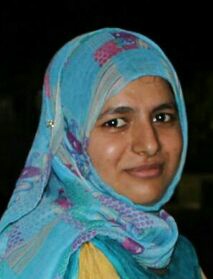Scientific Program
Keynote Session:

Mandeep Singh Azad
Scientist, Sher-e-Kashmir University of Agricultural Sciences and Technology of Jammu, IndiaTitle: Sustainable control of gastrointestinal parasites in goats of hilly areas of Jammu and Kashmir (India)
Biography:
Mandeep Singh Azad has completed Climate Change and food security e-course by FAO (united nation) in July 2018. In addition to that he had participated in 3 week Market access to food security course in Feb 2018, Wageningen University and Research, Netherlands. Certificate earned course on Sustainable Food Production through Livestock Health Management University of Illinois April, 2018. He was appointed as the senior member of Hong Kong Chemical, Biological& Environmental Engineering Society (HKCBEES), Hong Kong. Moreover, he is the recipient of 11 international fellowships.
Abstract:

Preeti Birwal
Scientist, Department of Processing and Food Engineering, Punjab Agricultural University, Punjab, IndiaTitle: Application of Emerging Pulsed Electric Field Technology in Fermented Milk Products
Biography:
Dr. Preeti, holds Ph.D degree in Dairy Engineering from ICAR-National Dairy Research Institute (NDRI), master’s degree (2014) in Food Process Engineering and Management from NIFTEM and graduation (2012) in Dairy Technology from ICAR-NDRI. She is recipient of university UG-Bronze medal. She has worked on empowerment of villagers in food processing sector by forming self-help groups, homemade products. She has won prizes in oral and poster presentations.
Abstract:
Milk is renowned as complete food since from time immemorial. India is the largest producer of milk in the world. In addition to achieving the set targets for production, it is extremely important to support the same with necessary processing technologies. Dairy products have been part of the socio-economic culture of the Indian sub-continent from time immemorial. Fermented products contribute to about 5% of the Indian Dairy products and accounts for an annual turnover of Rs. 2.8 thousand million. Pulsed electric field (PEF), which is one of the emergent non-thermal processing techniques, is widely considered as a viable alternative to conventional thermal processing. The present study was taken up to evaluate PEF treatment of raw milk as a potential technique to pre-treat raw milk before its conversion to fermented products such as curd or Dahi. Raw milk was treated with high voltage (PT) with square wave pulses (55kV, pulse width 900 µs, for 100 s at a frequency of 90 Hz) using a in house-assembled PEF applicator and evaluated for its effect when used to prepare curd. PEF treated milk in combination with conventional thermal treatment (PT-CHT) was employed as a positive control, while conventionally heated milk (CHT) was employed as a negative control in this evaluation. PT samples resulted in softer body of curd with higher acidity and microbial load, while the PT-CHT samples resulted in curd with better whey holding capacity and firmer texture compared to PT and CHT in isolation. Shelf life analysis revealed that a 25% reduction in shelf life curd prepared by PT, while the shelf life curd prepared using the CH and PT-CHT were similar. The study demonstrated the interactive effect of moderate heat and PEF treatment as a promising alternative to thermal process in improving the quality of curd, without compromising its shelf life.
Title: Effects of Plumage Colour on Measureable Attributes of Indigenous Chickens in North Central Nigeria
Biography:
Dr. Joseph J. Okoh received his PhD degree in Animal Science (Animal Breeding and Genetics) at the Abubakar Tafawa Balewa University, Bauchi, Nigeria. He joined the Federal University of Kashere, Gombe State, Nigeria as Lecturer II in the Department of Animal Science. He is a Senior Lecturer and Head of Animal Science Department. He holds the Professor Suleiman Bogoro’s Young Geneticist Award and the Bauchi State Governor’s Prize for the Best Graduating Student Project. He has also received commendation in Research and Publications by the Federal University of Kashere, Gombe, Nigeria. He has over 20 publications.
Abstract:
The influence of plumage colour on measureable attributes of 6176 adult indigenous chickens of mixed sex from four states of the North Central Zone of Nigeria namely; Nasarawa, Niger, Benue, Kogi and the Federal Capital Territory (FCT) Abuja were assessed. The overall average body weight of the chickens was 1.95 0.03kg. The body weights of black, white, black/white, brown, black/brown, grey and mottled chicken however were 1.87±0.04, 1.94±0.04, 1.95±0.03, 1.93±0.03, 2.01±0.04, 1.96±0.04 and 1.94±0.14kg respectively. Only body length did not vary by plumage colour. The others; body weight and width, shank, comb and breast length, breast height (P<0.001), beak and wing lengths (P<0.001) varied significantly. Generally, no colour was out rightly superior to others in all body measurements. However, body weight and breast height were both highest in black/brown chickens which also had the second highest breast length. Body width, shank, beak, comb and wing lengths were highest in grey chickens but lowest in those with white colour and combinations. Egg qualities were on the other hand mostly lowest in grey chickens. In selection for genetic improvement in body measurements, black/brown and grey chickens should be favoured. However, in view of the known negative relationship between body weight and egg attributes, selection in favour of grey plumage may result in chickens of poor egg attributes. Therefore, grey chickens should be selected against egg quality.
Oral Session 1:
- Animal Growth & Development | Genetics and Animal Breeding | Veterinary Medicine | Animal Biotechnology | Livestock Production | Animal Nutrition & Wellbeing | Dairy Food Production & Quality Control | Animal Behavior and Animal Welfare
Title: Effects of feeding time on survival rates, growth performance and feeding behaviour of juvenile catfish
Biography:
Researcher, Umaru Ali Shinkafi Polytechnic, Sokoto, Nigeria
Abstract:
The culture of Clarias gariepinus for fish production is becoming increasingly essential as the fish is contributing to the food abundance and nutritional benefit to family health, income generation and employment opportunities. Effect of feeding frequency was investigated over a period of ten (10) weeks; the experiment was conducted to monitor survival rates, growth performance and feeding behavior of juvenile catfish. The experimental fish were randomly assigned to five treatment groups; (i.e with different feeding frequency intervals) of 100 fish each. Each treatment was replicated twice with 50 fish per replicate. All the groups were fed with floating fish feed (blue crown®). The five treatments (feeding frequency) were T1- once a day feeding of night hours only, T2- twice a day feeding time of morning and night hours, T3- trice a day feeding time of morning, evening and night hours, T-4 four times a day feeding of morning, afternoon, evening, and night hours, T-5 five times a day feeding at four hours interval. There were significant differences (p> 0.05) among treatments. Feed intake and weight gain improved significantly (p<0.05) in T-4 and T-3. The best of the feeding time on weight gain, survival rate and feed conversion ratio were obtained at three times a day feeding (T-3) compared to other treatments especially those fed once and five times feeding regiment. This might be attributed to the high level of dissolve oxygen and less stress. Feeding fish three times a day is therefore recommended for efficient catfish production to maximize profits as the feed represents more than 50% of aquaculture inputs, particularly in intensive farming systems.
Title: In search of the Rhipicephalus (Boophilus) microplus in the western-central regions of the Eastern Cape Province
Biography:
Abstract:
The objective of the study was to determine the distribution of R. (B.) microplus under different ecological zones in the western-central regions of Eastern Cape Province. Engorged adult blue ticks were collected monthly from 360 randomly selected cattle and free-living ticks from six replicate drags of the vegetation over a period of 1 year at Bedford Dry Grassland (BDG), Kowie Thicket (KT) and Bhisho Thornveld (BT). Special attention was paid to the lower perineum, neck, dewlap and ventral body parts which are the preferred sites for blue ticks during sampling. In this study, 9 species of ticks which grouped under 5 genera were identified. A total of 4382 females and 3708 males of R. (B.) decoloratus were recovered during the survey. Of the ticks (n=2885) collected from the vegetation, R. (B.) decoloratus was the most abundant species with a relative prevalence of 58.16%, followed by R. appendiculatus (18.37%) and R. evertsi evertsi (16.90%). Least abundant ticks were H. rufipes (2.98%), A. hebraeum (2.46%), H. elliptica (0.38%), R. follis (0.34%), I. pilosus (0.24%) and R. simus (0.17%). The distribution of R. (B.) decoloratus ticks differ significantly (P < 0.05) among the vegetation types. More (P < 0.05) engorged R. (B.) decoloratus were collected in KT during summer season compared to other vegetation types. R. (B.) microplus was not found in the present study, signifying that it is not yet established in western-central regions of the Eastern Cape Province and as such, continuous monitoring would be advisable.

Prayag Siddalingappa
Assistant Professor, Department of Animal Genetics and Breeding, Veterinary College, HEBBAL, Bangalore, IndiaTitle: Scientific Mitigation Measures Followed By Karnataka Government To Overcome Human-Tiger Interaction in G.S Betta Range, Bandipur Tiger Reserve.-A Case Study
Biography:
Dr. Prayag Siddalingappa is currently working as Assistant Professor in Department of Animal genetics and Breeding Veterinary College, Bangalore, KVAFSU, Bidar. He holds the experience of working in wildlife field since 2003 till date in different capacities. He participated in PREDICT WORKSHOP on EMERGING WILDLIFE INFECTIOUS DISEASES conducted by USAID. Project on DNA Barcoding of Giraffe in Indian zoo and their genetic characterization has been successfully completed by him. He participated in IMMOBILIZATION , CAPTURE & TRANSPORTATION OF WILD ANIMALS conducted by KARNATAKA FOREST DEPT & WILD LIFE INSTITUTE OF INDIA at BANDIPUR to mention major few.
Abstract:
Tigers are highly elusive ,adaptable species and are also found in and around human dominated areas and agricultural lands.In India Human-Tiger Interaction is becoming more common and is now major issue in forest side villages, causing loss of lives of humans as well as animals. The present case study aims to provide a brief analysis of the work carried out by Karnataka Forest Department to rescue and translocate the conflict causing Tiger from G.S Betta range of Bandipur Tiger Reserve Karnataka to a safer place away from human interference. An adult Tiger in G.S Betta range was suspected to eaten an elderly farmer in his agricultural field during cattle grazing in 2 September 2019 followed by one more human kill in 8 October 2019 causing public uproar and hostility. We present our observations made of tiger by villagers in (September 2019), later field study was done after second suspected kill made by the same tiger until the tiger was rescued, translocated and monitored for rehabilitation. Scientific conflict mitigation measures were followed as per National Tiger Conservation Authority (NTCA) protocol, and IUCN Guidelines, under field conditions. The precautionary measures to adopted were explained to the villagers and awareness was created in the impacted villages.The individual tiger was identified using pug marks for sex identification on field, camera traps images for unique stripe pattern and was then successfully rescued by chemical immobilisation, transported in cage to Mysore Zoo's Rescue and rehabilitation centre for medical examination. When all evidences were collated, it was observed that the tiger in question did not seek human or livestock prey outside the PA. It must be accidental encounter with humans. It can be concluded that for long term solution, better understanding of animal behaviour is a must. Along with this awareness among people about dispersing tigers would influence their perception of man-eater tigers. The key to success of this operation was the decision made by KFD based on scientific techniques to identify the tiger and capture it.

Dr. Samuel Okezie Ekere
Department of Veterinary Obstetrics and Reproductive Diseases, University of Nigeria, Nsukka. Enugu State, NigeriaTitle: Epididymal Sperm Characteristics, Testicular Morphometric Traits and Growth Parameters of Rabbit Bucks Fed Dietary Saccharomyces cerevisiae and/or Zinc Oxide.
Biography:
Dr. Ekere was born in Zaria, Kaduna, were he did his Nursery and Part of his Primary education. He finished his primary education in the University of Nigeria, Nsukka Staff School. Dr. Ekere Samuel Okezie completed his Doctor of Veterinary Medicine at the age of 25 years from the University of Nigeria, Nsukka; he also bagged his Master of Science in Veterinary Andrology in 2014. He was also awarded his Fellowship award from the College of Veterinary Surgeons, Nigeria. He is currently a Lecturer in the Department of Veterinary Obstetrics and Reproductive Diseases, University of Nigeria, Nsukka. He has published more than 19 papers in reputed journals and has been serving as an editorial board member of reputed journals.
Abstract:
Title: Control of Ticks: Past to Present Scenario
Biography:
My area of interest are epidemiology and control of arthropod borne parasitic diseases and currently working on ticks’ control, I have worked as research associate in a USAID-CAS-AFS funding project titled: Metagenomics of Mosquito Vectors and Abundance of Mosquito-borne pathogens in different agr0-geoclimatic areas of Punjab, Pakistan. Now I am working as Research fellow in a Pakistan Agriculture Research Council project titled: Epidemiology, Advance Diagnosis and Biological Control Model of Ticks and Tick-borne Diseases in Ruminants at Two Ecologies of Pakistan.
Abstract:
Title: DISASTER MANAGEMENT- A CHALLENGE FOR FIELD VETS OF INDIA
Biography:
Dr.Tejinder Singh Has completed his Master Veterinary Science degree from GADVASU Ludhiana, He is working with state animal husbandry department Uttar Pradesh since 2007 as Veterinary Officer.He has published one book titled Handbook of wild and zoo animal health care and management, and more than 30 research and clinical papers in national and international journals.
Abstract:
Disaster causes serious disruption of society causing damage to human as well as animal lives. India is vulnerable, in varying degrees, to a large number of disasters. More than 58.6 per cent of the landmass is prone to earthquakes of moderate to very high intensity; over 12% of its land is prone to floods and river erosion; 8% coastline is prone to cyclones and tsunamis; 68% of its cultivable area is vulnerable to droughts; and, 3% hilly areas are at risk from landslides and avalanches Moreover, India is also vulnerable to Chemical, Biological, Radiological and Nuclear (CBRN) emergencies and other man-made disasters. Disaster causes severe loses in livestock sector causing huge and sudden loss to farmers as well as livestock industry. Disaster management broadly divided two-point framework, pre disaster risk reduction phase and post disaster recovery phase. Disaster management has four main components: Preparedness before disaster strikes by adopting advanced weather forecasting technology and early warning system, Mitigation efforts attempt to prevent hazards from developing into disasters altogether, or to reduce the effects of disasters when they occur, i.e. making the effect of the disaster less severe by understanding hazard, vulnerability and risk assessment, Response time to a disaster must be as minimum as possible it includes the mobilization of the necessary emergency services and first responders in the disaster area. and Recovery phase is to restore the affected area to its previous state, which takes time In case of livestock with preparedness, pre disaster, during disaster and after disaster is helpful to reduce the livestock loss during disaster and minimize its effect on livestock population.






